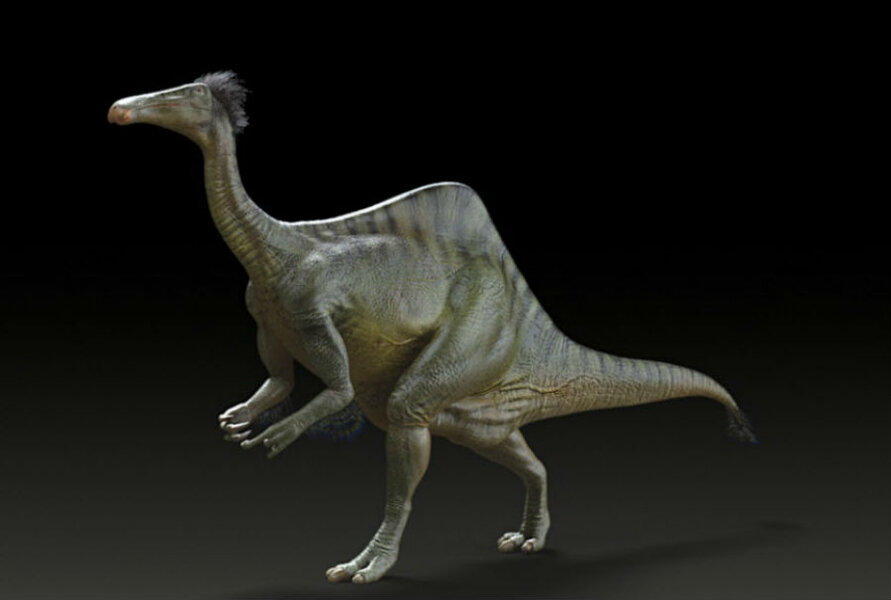Humongous, toothless wonder of a dinosaur unveiled
Loading...
Perhaps it's only fitting that Mongolia, whose one-time leader led the largest contiguous empire in the world, also has yielded the largest dinosaur of its type yet found – Deinocheirus mirificus, a 70-million-year-old, 6.4-ton, 36-foot-long creature vaguely resembling a cross between a pumped-up prehistoric Big Bird and the Hunchback of Notre Dame.
Scientists have assembled two partial skeletons that together present a nearly complete picture of the animal – once known only by a smattering of shoulder bones and two forearms roughly eight feet long. The team describes their reconstruction in a paper set to appear in Thursday's issue of the journal Nature.
The reconstruction allowed the team to place D. mirificus squarely among a group of dinosaurs known as ornithomimosaurs, creatures that had a general, ostrich-like structure and feasted either on plants or on a mix of plants and animals. Although ornithomimosaurs have an ostrich-like appearance, they represent an offshoot of the main branch of theropod dinosaurs that also would yield birds.
Among ornithomimosaurs, D. mirificus was the largest of the lot, according to the international researchers, led by Yuong-Nam Lee, a researcher with the Korea Institute of Geoscience and Mineral Resources in Daejeon, South Korea.
The reconstruction came together through some shrewd detective work after poachers had made off with the parts of the skeleton that likely would fetch the highest prices from private collectors, the researchers report.
The initial, sparse evidence for D. mirificus was uncovered in 1965 by a joint expedition of Polish and Mongolian researchers. Based on the enormous forearms with nasty trio of claws at the business ends, the researchers gave the creature its name, which translates to "unusual, horrible hand."
Fast forward to 2006, when a joint South Korean-Mongolian expedition unearthed more fossil remains from a area of the Gobi Desert known as the Nemegt Formation – layers of shale and sandstone dating from the late Cretaceous, the beginning of the end for the reign of dinosaurs.
The geology testified to an ancient, forested environment with lakes and rivers. But the surface testified to the activity of poachers, who had heavily damaged the area. In 2009, the expedition worked at a second site, about 30 miles away. Poachers had heavily damaged it as well, exposing various bones belonging to another D. mirificus specimen as well as absconding with the skull, hands, and feet.
Two years later, Pascal Godefroit, a researcher with the Royal Belgian Institute of Natural Sciences got word that the head and feet were in the hands of a private collector in Germany, arriving by way of Japan. Last May, the researchers explain, the poached dino parts were returned to Mongolia, where researchers found that a repatriated toe bone was a Cinderella-like fit to another bone on the same toe that the team has collected from the 2009 site.
With two partial skeletons in hand, the researchers have reconstructed a single, virtually whole skeleton. The fossil remains don't only reveal D. mirificus' overall structure. The team found evidence of what one of the two specimens had as a last supper. The team found fossilized fish backbones and scales amid small, rounded stones that D. mirificus ingested to help it digest its meal. D. mirificus, it turns out, was a toothless wonder.
Indeed, its deep lower jaw is one of its oddities. The depth of the jaw and its massive bones are more reminiscent of large carnivores such as Tyrannosaurus rex than of other ornithomimosaurs. But it was a jaw built for browsing through the understory of trees.
The “horrible hands,” likely were used for digging or to gather plants, the researchers say.
Its substantial hind legs, large feet, and wide hips suggest that haste was not a regular feature of D. mirificus's locomotion. And the feet appear well adapted to keeping the behemoth from getting stuck in muddy river banks.
“The discovery of the original specimen almost half a century ago suggested that this was an unusual dinosaur, but did not prepare us for how distinctive Deinocheirus is,” the team writes.
At the least, the researchers say, D. mirificus serves as “a true cautionary tale” about the difficulties of figuring out the shape of prehistoric creatures and their place on the evolutionary tree from a few bits of fossilized bones.






